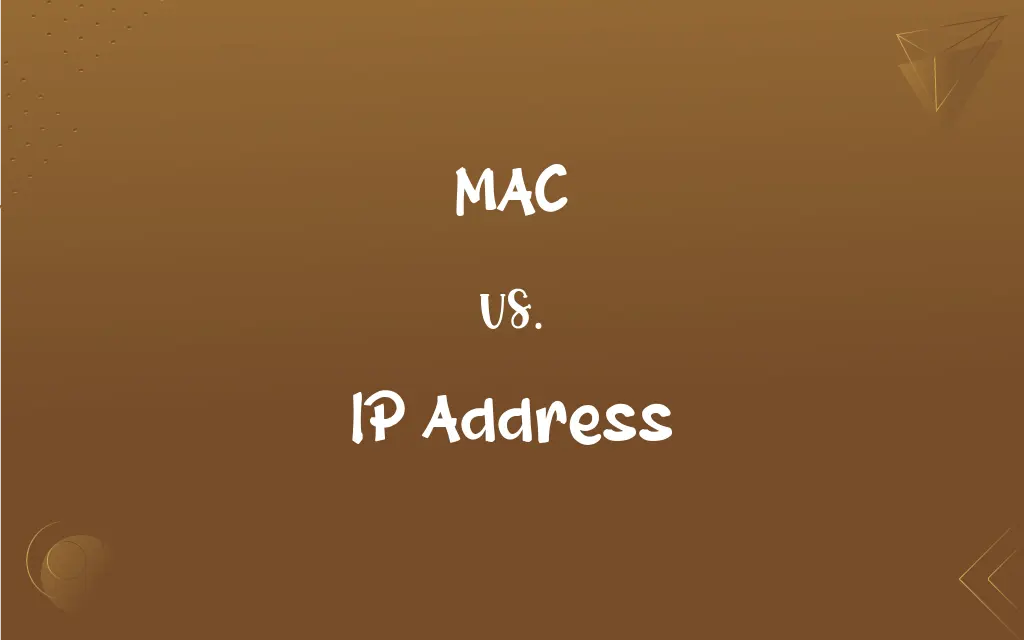MAC vs. IP Address: What's the Difference?
Edited by Janet White || By Harlon Moss || Published on January 22, 2024
A MAC address is a unique hardware identifier for network devices, while an IP address identifies devices on a network and enables internet communication.

Key Differences
A MAC (Media Access Control) address is a unique identifier assigned to network interfaces for communications at the data link layer of a network segment. An IP (Internet Protocol) address, on the other hand, is assigned to a device connected to a network and facilitates the identification and communication over an IP network like the internet.
MAC addresses are permanently assigned to a device's network interface card (NIC) by the manufacturer, making them static and unique worldwide. In contrast, IP addresses can be dynamic, changing with network connection, or static, assigned for prolonged use. They are not inherently tied to the hardware.
The format of a MAC address is a 12-digit hexadecimal number, typically displayed in six groups of two digits. IP addresses come in two versions: IPv4, a 32-bit number often expressed in dot-decimal notation, and IPv6, a 128-bit number expressed in hexadecimal notation.
A MAC address operates within the local network to ensure the physical device's identity, while an IP address is used across networks to locate and identify devices globally. This distinction allows MAC addresses to assist in directing data packets on the local network, whereas IP addresses facilitate data transfer across different networks.
The role of a MAC address is largely confined to network hardware identification and doesn't change as a device moves between networks. However, an IP address can change when a device switches networks, reflecting its current network location and identity.
ADVERTISEMENT
Comparison Chart
Full Form
Media Access Control address
Internet Protocol address
Nature
Hardware-specific, static
Network location-specific, can be dynamic or static
Format
12-digit hexadecimal
IPv4: 32-bit dot-decimal; IPv6: 128-bit hexadecimal
Role in Networking
Identifies devices on a local network
Identifies and locates devices across networks
Assigned By
Manufacturer of the NIC
Network administrator or dynamically by the network
ADVERTISEMENT
MAC and IP Address Definitions
MAC
Assigned to network interface cards.
The router recognizes devices by their MAC addresses.
IP Address
An address for devices on an IP network.
Each device on the internet is assigned an IP address.
MAC
Typically unchangeable and set by the manufacturer.
A device's MAC address stays the same regardless of the network it connects to.
IP Address
Facilitates sending and receiving data online.
The website's IP address directs traffic to the correct server.
MAC
A unique identifier for network devices.
Each network card has a distinct MAC address.
IP Address
Either 32-bit or 128-bit addresses.
IPv4 addresses are running out, leading to the adoption of IPv6.
MAC
Operates at the data link layer.
MAC addresses facilitate local network communication.
IP Address
Can be permanent or change with network.
Her home network assigns a dynamic IP address to her laptop.
MAC
Expressed in 12 hexadecimal characters.
The MAC address is displayed as six groups of two hexadecimal digits.
IP Address
Each active device has a unique IP.
Your IP address can be used to approximate your geographic location.
MAC
Used as a form of address for a man whose name is unknown.
MAC
A mackintosh.
MAC
Clipping of mackintosh
MAC
Clipping of macaroni
Is there any mac and cheese left?
MAC
Shortened form of Macintosh, a brand name for a personal computer; as, the latest Mac has great new features.
MAC
A prefix, in names of Scotch origin, signifying son.
MAC
Shortened form of mackintosh, a waterproof raincoat made of rubberized fabric.
MAC
A waterproof raincoat made of rubberized fabric
FAQs
What is a MAC address?
A unique identifier for a device's network interface card.
Can a MAC address be changed?
Generally, MAC addresses are permanently assigned and cannot be changed.
What is an IP address?
A numeric label assigned to each device connected to a computer network that uses the Internet Protocol for communication.
How many digits are in a MAC address?
A MAC address consists of 12 hexadecimal digits.
Is a MAC address unique worldwide?
Yes, each MAC address is unique globally.
Is a MAC address visible over the internet?
No, MAC addresses are used locally within a network, not over the internet.
How is an IP address assigned?
Either dynamically by the network upon connection or statically assigned for fixed use.
Can IP addresses be the same on different networks?
Yes, especially in private networks.
Can IP addresses be tracked?
Yes, they can be used to track the network location of a device.
Do mobile devices have IP addresses?
Yes, when connected to a network.
Do IP addresses provide location information?
They can approximate location, but not as precisely as GPS.
What are the two types of IP addresses?
IPv4 and IPv6.
Can two devices have the same MAC address?
In theory, no, but MAC address spoofing can occur.
Who assigns a MAC address to a device?
The device manufacturer.
What layer of networking does MAC operate on?
The data link layer of the OSI model.
Are MAC addresses relevant for Wi-Fi?
Yes, they identify devices in a Wi-Fi network.
Why are IPv6 addresses important?
They provide a larger address space than IPv4.
What happens if an IP address conflict occurs?
Network errors and connectivity issues can arise.
How do IP addresses affect internet privacy?
They can be used to track online activity and location.
What is a common format for a MAC address?
Six groups of two hexadecimal digits.
About Author
Written by
Harlon MossHarlon is a seasoned quality moderator and accomplished content writer for Difference Wiki. An alumnus of the prestigious University of California, he earned his degree in Computer Science. Leveraging his academic background, Harlon brings a meticulous and informed perspective to his work, ensuring content accuracy and excellence.
Edited by
Janet WhiteJanet White has been an esteemed writer and blogger for Difference Wiki. Holding a Master's degree in Science and Medical Journalism from the prestigious Boston University, she has consistently demonstrated her expertise and passion for her field. When she's not immersed in her work, Janet relishes her time exercising, delving into a good book, and cherishing moments with friends and family.






































































